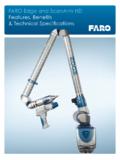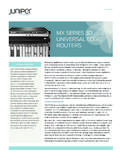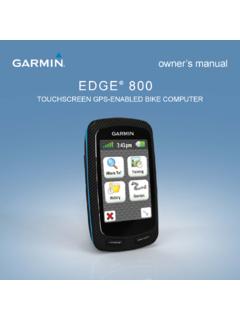Transcription of Semiconductor Wafer Edge Analysis - prostek.com
1 Semiconductor Wafer Edge Analysis /1 Semiconductor Wafer Edge Analysis Chapman Technical Note-TW-1 Rev-98-07 Semiconductor Wafer Edge Analysis /2 Introduction The reason for evaluating Semiconductor Wafer edge microroughness is that edge defects can sometimes adversely affect Semiconductor performance. Problems range from features that trap liquid or airborne particles to rough surface protrusions that may become detached and release silicon particles during processing. These problems have led to an ASTM standards effort that includes the definition of a standard for the measurements of the surface topography of Semiconductor edges . Chapman Instruments has participated in recent activities of both ASTM and SEMI standards committees. This application note presents information on the types of measurements required for Wafer edge processing.
2 Edge measurements are included that show several regions at or near the actual edge boundary. These measurements include roughness parameters useful for quantifying the surface topography. Other parameters included selectively emphasize either peaks or valleys. Each of these parameters can provide distinctive information for quantifying the Semiconductor edge surface conditions. Finally, guidelines are provided in accordance with the ASTM standards committee to aid in measurement of Semiconductor edges . Wafer Edge Background Recent standard guidelines have been developed for the measurement of the edge surface roughness (ASTM edge roughness standard preliminary version only). Essentially, these guidelines define the measurement locations around the Wafer edge and the reporting requirements.
3 Two typical edge types are encountered in the Semiconductor industry: rounded or blunt shape bullet or beveled shape Figure 1(a) on the following page shows the two common Wafer edge types and their edge geometries. Figure 1(b) shows the edge geometry shape that is specified by SEMI M1 ( Semiconductor Equipment and Materials International). The bevel regions on bullet-shaped wafers are typically ground at 22-degree angles to the main surfaces of the Wafer , while blunt wafers have a smooth transition from the flat Wafer surface to the actual edge. Figure 1 also shows the five regions constituting the edge of the Wafer . These five regions are: the transition area between the polished side and the edge (C), the front side bevel or rounded region (B), the crown or apex (A), the back side bevel or rounded region (D), and the transition area between the back side and the edge (E).
4 Unpolished edges typically exhibit a surface pattern formed from a grinding process. Surface peaks will touch carrier walls, while valleys will trap particles and impurities. These particles can then propagate to the Wafer surface and increase the risk of Wafer chipping. Also, deep wells in the edge can be a location site for phosphorus during doping. Phosphorus that is trapped in these locations can then be chipped out in handling. Thus, edge polishing may be required to minimize these surface irregularities. Semiconductor Wafer Edge Analysis /3 Semiconductor Wafer Edge Analysis /4 Stricter requirements in the Wafer manufacturing process have made edge measurements important for both 200 mm and 300 mm wafers. In fact, the SEMI standard for 300 mm wafers specifically requires a polished edge.
5 Polishing the edge is done in order to reduce Wafer cracking and chipping under stress during transport or thermal processing. This applies to all types of wafers, especially bonded wafers. The degree of polishing needs to be monitored by a surface inspection tool. The Chapman profiling system is capable of measuring both across and along all areas of the edge, providing the Wafer manufacturer with the feedback necessary to accurately control their edge polishing process. Wafer Edge Measurements As outlined in the preceding paragraphs, edge roughness control is becoming an integral issue in the production of Semiconductor wafers. Non-contact measurement techniques are beneficial because they do not contaminate the sample and typically do not require considerable preparation. The SEMI standards committee included the Chapman Instruments MP2000 Plus system for reporting profile and roughness information on the Wafer edge.
6 Three types of wafers were used for the SEMI standards committee study: caustic-etched acid-etched polished These same three types of wafers will be used in our examples to show typical results. All measurements in this document were acquired with an MP2000 Plus Non-Contact Surface Profiler configured with a 50X objective and a Nomarski II prism. This optics combination has a spatial resolution of m with a maximum surface slope of degrees. Semiconductor Wafer Edge Analysis /5 Transition Region The first Wafer location examined is the transition region from the polished Wafer surface to the front bevel (Figure 1, locations C and E). Measurement of the transition region can be used to detect multiple problems, such as the existence of defects, and can certify the shape of the edge.
7 Figure 2 shows measurement results from transition regions of both rounded and beveled wafers. The top graph shows the roll-off profile of the transition region of a rounded Wafer . The evaluation length is shown from zero to 8,512 m. The original scan length was 10 mm (10000 m), which was automatically modified to 8,512 m with the edge-finding algorithm incorporated into the operational software of the MP2000 Plus system. The rounded edge gradually rolls off as one would expect. The bottom graph shows the roll-off profile of the transition region of a bevel Wafer . The scan length on this trace is shown from zero to 8,974 m. As anticipated, the roll-off profile of the transition region has a flat region at the end of the measurement. The vertical scales are different for the two graphs; the rounded shape extends to m, while the bevel extends to m.
8 Figure 2 Semiconductor Wafer Edge Analysis /6 Figure 3 shows an example of an edge measurement of a thin bonded Wafer . This demonstrates defects leading up to and within the transition region of a rounded Wafer edge. The upper plot shows the roughness calculated with a high pass filter (cutoff filter) of 250 m over a distance of 6,000 m. This type of cutoff filter is recognized by the International Standards Organization (ISO) for separating the boundary between waviness (long spatial features) and roughness (short spatial features). Within this plot, a few small point defects are clearly visible within the region leading up to the transition region. Several common surface parameters are shown in the graph, including: Ra, the roughness average Rpm, the average peak height RMS(Rq), the RMS roughness Rvm, the average valley depth Rt, the peak to valley (max to min) Sm, the average spacing of surface features The Performance Plus software provides access to many other parameters and functions, including histogram plots, cumulative distribution, power spectral density, and autocovariance.
9 Figure 3 The bottom plot depicts the roll-off profile of the transition region of the edge. The roll-off profile is shown from zero to the edge at 8,521 m. In this graph, the roll-off profile is not rounded as in Figure 2, but has disparities in the edge region. Semiconductor Wafer Edge Analysis /7 Bevel The configuration for measurement of the bevel edge roughness must include a provision for tilting the Wafer . One such configuration is shown in Figure 4. This measurement setup shows the Wafer tilted so that the primary measurement area is perpendicular to the focused laser spot. The measurement is taken by beginning on the Wafer surface. The optical system then moves across and over the bevel surface. Figure 4 Figure 4 shows the bevel setup configuration at the beginning of the measurement (A) and on the bevel (B).
10 The Chapman Instruments MP2000 Plus system uses a dual autofocus system to keep the small beam spot in focus as it translates across the Wafer surface and then over the Wafer edge. This dual autofocus system is necessary to ensure that high spatial frequency information is contained in the entire surface topography record. Semiconductor Wafer Edge Analysis /8 The complete measurement shows the surface topography, which includes the shape and roughness of the edge. Chapman Instruments software automatically shows both profile and roughness information. Figure 5 shows an example of the complete data from an edge measurement in the same configuration as shown in Figure 4. The top trace of Figure 5 shows the profile data with the overall shape of the Wafer and bevel edge surface. The bottom trace shows the roughness on just the Wafer edge.






